Do not trust emails asking you to confirm your Trust Wallet recovery phrase
Phishing/ScamAlso Known As: Trust Wallet phishing email
Get free scan and check if your device is infected.
Remove it nowTo use full-featured product, you have to purchase a license for Combo Cleaner. Seven days free trial available. Combo Cleaner is owned and operated by RCS LT, the parent company of PCRisk.com.
What is kind of email is "Trust Wallet"?
After inspecting this "Trust Wallet" email, we determined that it is spam that operates as a phishing scam. Letters of this spam campaign are presented as alerts regarding the imminent suspension of recipients' "Trust Wallets" - to prevent which the log-in credentials have to be re-verified.
It must be emphasized that these emails are fake, and they are in no way associated with the real Trust Wallet cryptocurrency wallet.
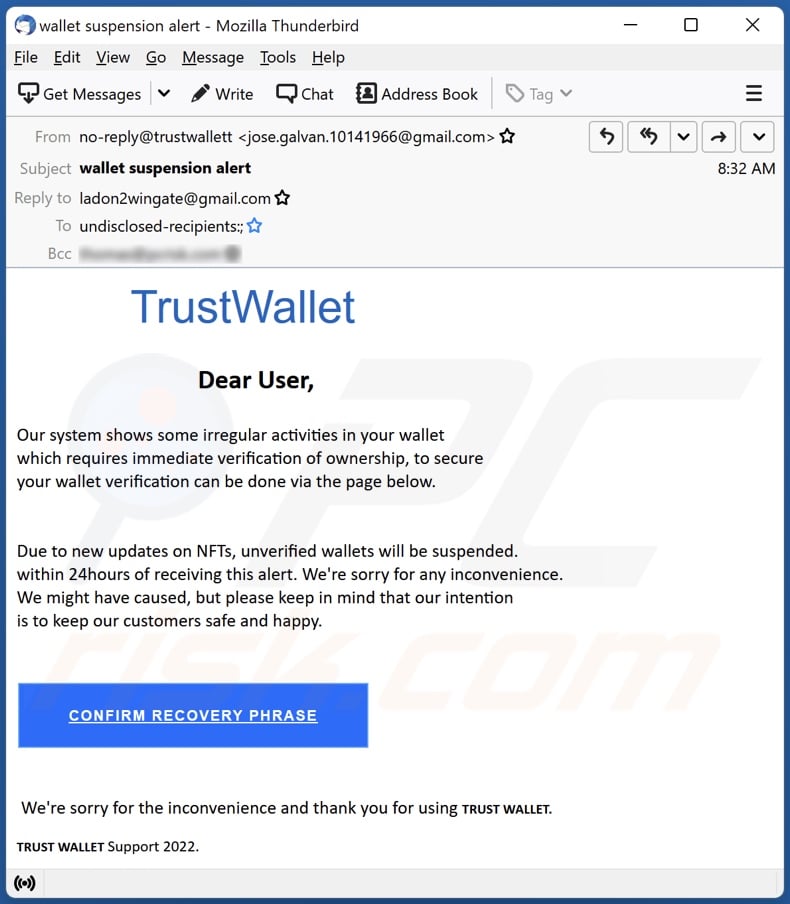
"Trust Wallet" email scam overview
The spam email with the subject "wallet suspension alert" (may vary) inform the recipient that irregular activity has been detected within their "Trust Wallet". Hence, the recipient is asked to verify their ownership of the digital wallet, as new updates regarding NFTs mean that unverified wallets will be suspended 24 hours after the owner is notified.
As mentioned in the introduction, this notification is fake. Therefore, when the "CONFIRM RECOVERY PHRASE" button is pressed, it results in a redirect to a phishing site. This page is nearly identical to the legitimate Trust Wallet website.
The deceptive webpage requests the visitor to enter their email address (where they wish to receive the security code), wallet recovery phrase, and complete the CAPTCHA verification. If tricked by this website, victims will unintentionally expose their Trust Wallet credentials to the scammers behind this spam campaign.
With said information in their possession, the cyber criminals can gain access to the compromised wallet and gain control over the funds stored therein.
If you have already provided your credentials - immediately change them and contact Trust Wallet's official support.
| Name | Trust Wallet phishing email |
| Threat Type | Phishing, Scam, Social Engineering, Fraud |
| Fake Claim | Recipient's Trust Wallet will be suspended unless its ownership is re-verified. |
| Disguise | Trust Wallet |
| Symptoms | Unauthorized online purchases, changed online account passwords, identity theft, illegal access of the computer. |
| Distribution methods | Deceptive emails, rogue online pop-up ads, search engine poisoning techniques, misspelled domains. |
| Damage | Loss of sensitive private information, monetary loss, identity theft. |
| Malware Removal (Windows) |
To eliminate possible malware infections, scan your computer with legitimate antivirus software. Our security researchers recommend using Combo Cleaner. Download Combo CleanerTo use full-featured product, you have to purchase a license for Combo Cleaner. 7 days free trial available. Combo Cleaner is owned and operated by RCS LT, the parent company of PCRisk.com. |
Phishing spam campaign examples
We have analyzed thousands of spam emails; "A Law Case Filed Against Your Company", "Login Session Authentication", and "M&T Bank email scam" are merely a few examples of phishing letters.
This mail is usually presented as "urgent", "important", "priority", and similar; it can even be disguised as notifications/messages from legitimate companies, institutions, organizations, authorities, or other entities. In addition to scams, spam emails are also used to proliferate trojans, ransomware, cryptominers, and other malware.
How do spam campaigns infect computers?
Spam emails can contain infectious files as attachments or download links. These files can be archives (RAR, ZIP, etc.), executables (.exe, .run, etc.), Microsoft Office and PDF documents, JavaScript, and so on.
When a virulent file is executed, run, or otherwise opened - malware download/installation is jumpstarted. For example, Microsoft Office documents infect systems by executing malicious macro commands.
How to avoid installation of malware?
We strongly advise being cautious with incoming mail. The attachments and links found in suspect/irrelevant emails and messages - must not be opened since that can result in a system infection. It is essential to use Microsoft Office versions released after 2010, as they have the "Protected View" mode that prevents automatic macro execution.
However, malware is not proliferated exclusively via spam mail. Therefore, we also recommend downloading only from official/verified sources and activating/updating software with legitimate tools (as illegal activation tools ["cracks"] and third-party updaters may contain malware).
We must stress the importance of having a reputable anti-virus installed and kept up-to-date. Security programs must be used to run regular system scans and to remove detected threats. If you've already opened malicious attachments, we recommend running a scan with Combo Cleaner Antivirus for Windows to automatically eliminate infiltrated malware.
Text presented in the "TrustWallet" scam email letter:
Subject: wallet suspension alert
TrustWallet
Dear User,
Our system shows some irregular activities in your wallet
which requires immediate verification of ownership, to secure
your wallet verification can be done via the page below.
Due to new updates on NFTs, unverified wallets will be suspended.
within 24hours of receiving this alert. We're sorry for any inconvenience.
We might have caused, but please keep in mind that our intention
is to keep our customers safe and happy.
CONFIRM RECOVERY PHRASE
We're sorry for the inconvenience and thank you for using TRUST WALLET.
TRUST WALLET Support 2022.
Screenshot of the phishing website promoted by the "TrustWallet" spam campaign:
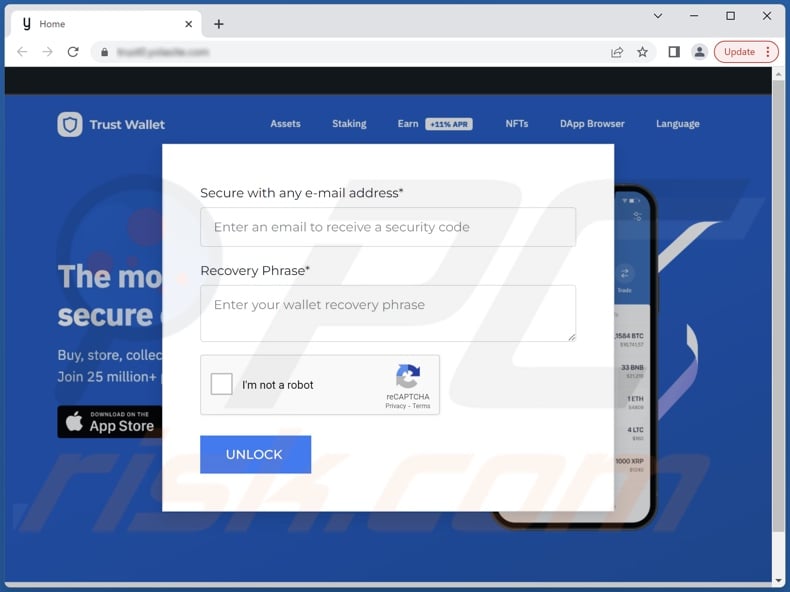
Another example of TrustWallet-themed spam email promoting a phishing site:
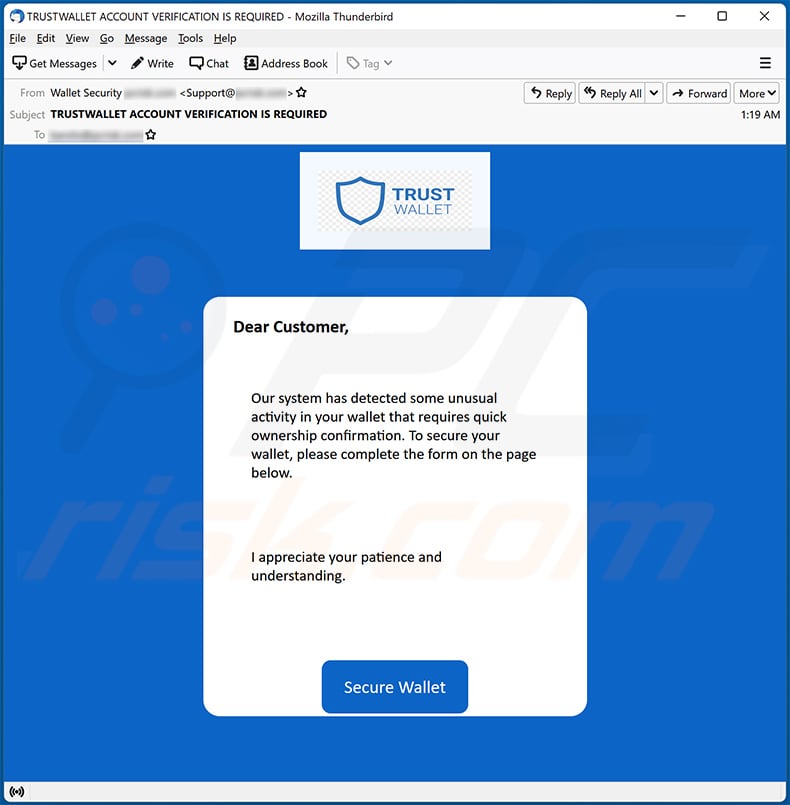
Text presented within:
Subject: TRUSTWALLET ACCOUNT VERIFICATION IS REQUIRED
TRUSTWALLET
Dear Customer,Our system has detected some unusual activity in your wallet that requires quick ownership confirmation. To secure your wallet, please complete the form on the page below.
I appreciate your patience and understanding.
Secure Wallet
Yet another example of TrustWallet-themed spam email promoting form asking to enter various private details including TrustWallet account recovery phrase:
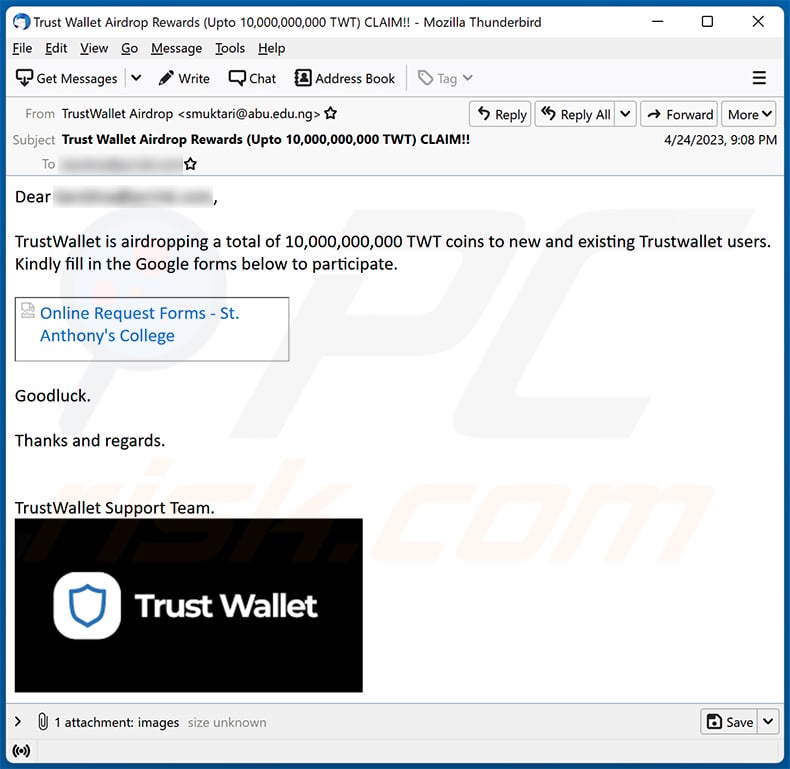
Text presented within:
Subject: Trust Wallet Airdrop Rewards (Upto 10,000,000,000 TWT) CLAIM!!
Dear -,
TrustWallet is airdropping a total of 10,000,000,000 TWT coins to new and existing Trustwallet users.
Kindly fill in the Google forms below to participate.Online Request Forms - St. Anthony's College
Goodluck.
Thanks and regards.
TrustWallet Support Team.
Press Kit | Trust Wallet
Screenshot of the promoted form:
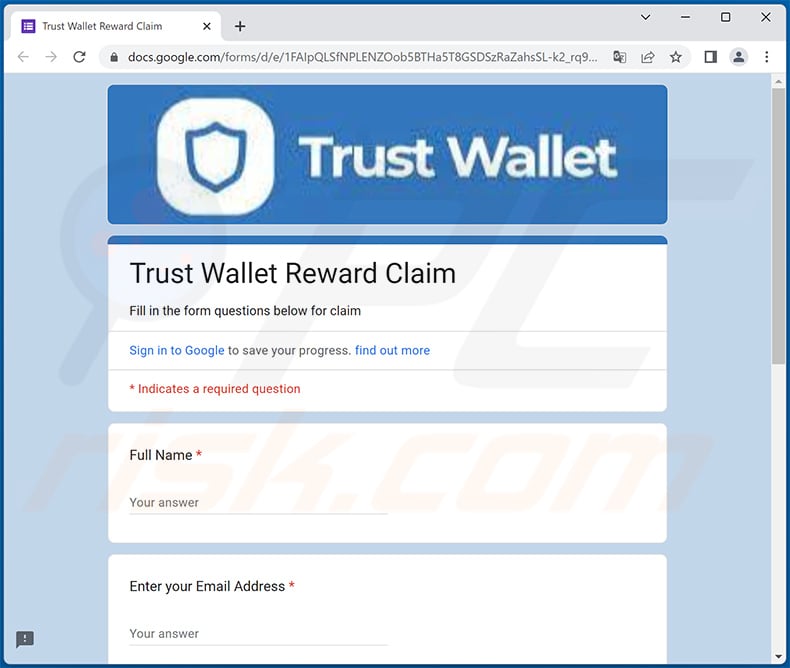
Yet another example of TrustWallet-themed spam email promoting a phishing site:
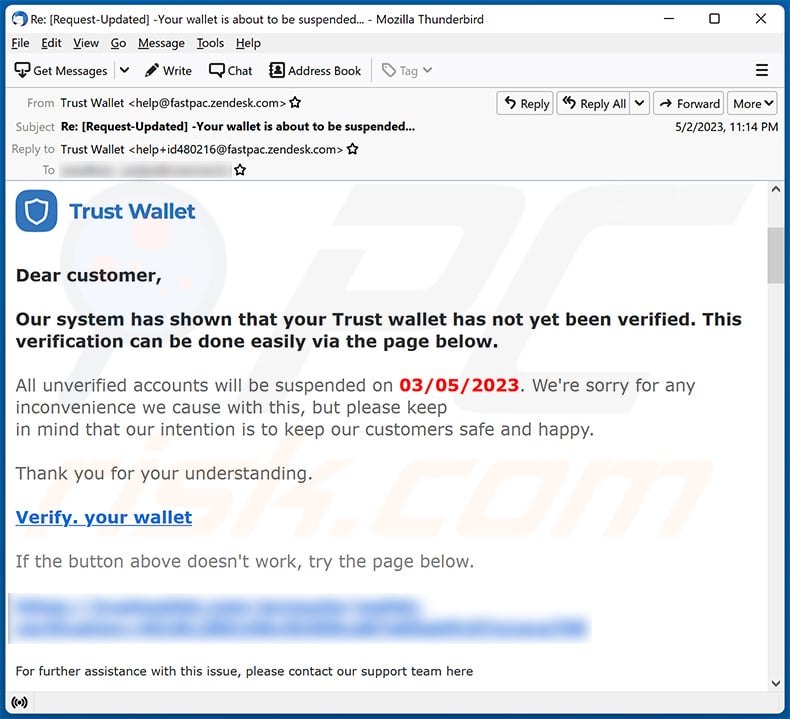
Text presented within:
Subject: Re: [Request-Updated] -Yоuг wаllеt is abоut to be susреndеd...
Dear customer,
Our system has shown that your Trust wallet has not yet been verified. This verification can be done easily via the page below.
All unverified accounts will be suspended on 03/05/2023. We're sorry for any inconvenience we cause with this, but please keep
in mind that our intention is to keep our customers safe and happy.
Thank you for your understanding.
Verify. your wallet
If the button above doesn't work, try the page below.
-
For further assistance with this issue, please contact our support team here
Screenshot of the promoted phishing site:
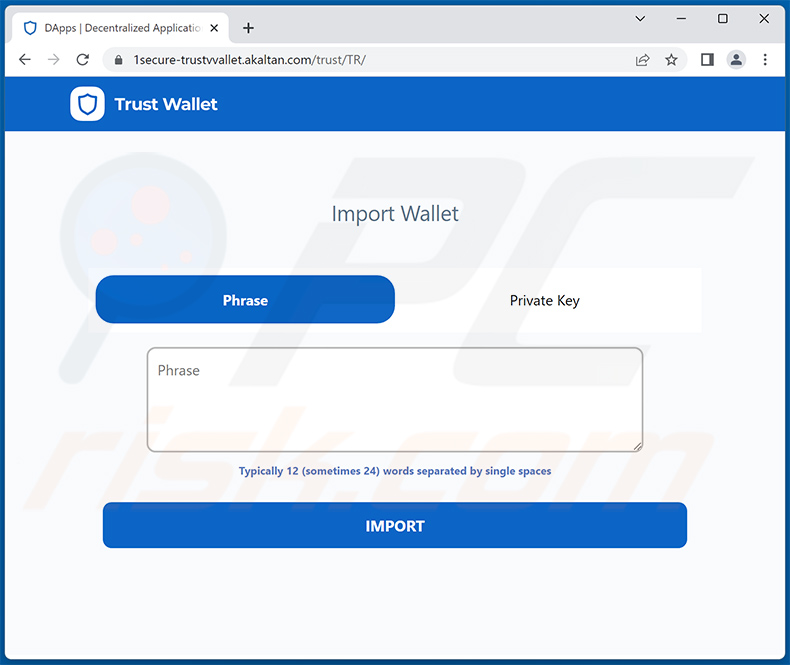
Screenshot of another phishing site promoted via TrustWallet-themed spam email:
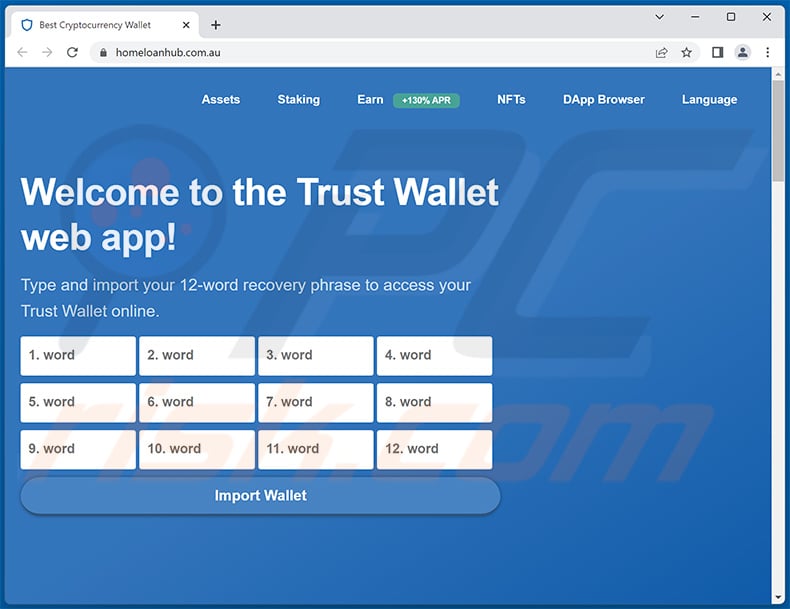
Yet another example of an email from TrustWallet spam campaign:
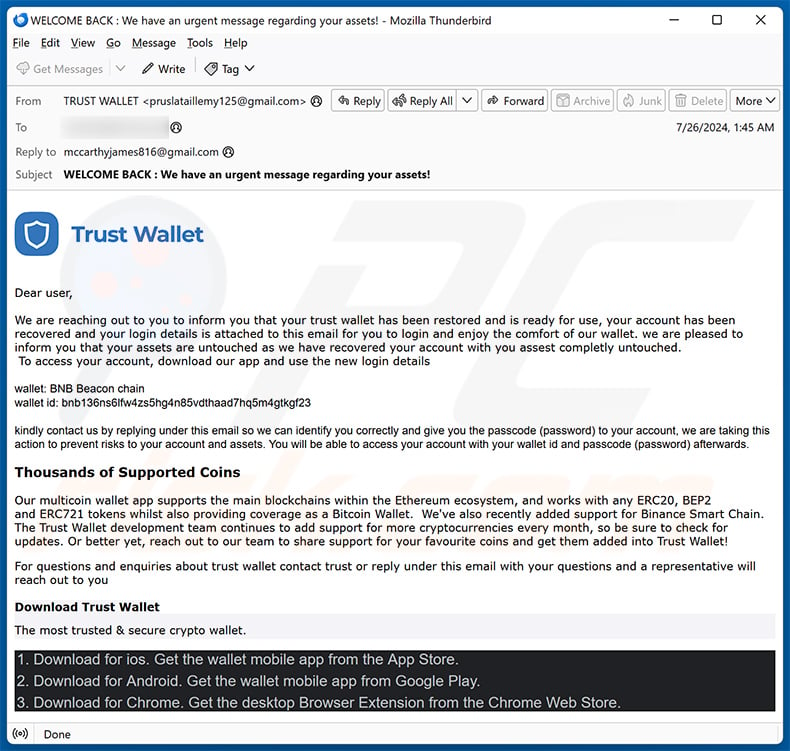
Text presented within:
Subject: WELCOME BACK : We have an urgent message regarding your assets!
Dear user,
We are reaching out to you to inform you that your trust wallet has been restored and is ready for use, your account has been recovered and your login details is attached to this email for you to login and enjoy the comfort of our wallet. we are pleased to inform you that your assets are untouched as we have recovered your account with you assest completly untouched.
To access your account, download our app and use the new login details
wallet: BNB Beacon chain
wallet id: bnb136ns6lfw4zs5hg4n85vdthaad7hq5m4gtkgf23
kindly contact us by replying under this email so we can identify you correctly and give you the passcode (password) to your account, we are taking this action to prevent risks to your account and assets. You will be able to access your account with your wallet id and passcode (password) afterwards.
Thousands of Supported CoinsOur multicoin wallet app supports the main blockchains within the Ethereum ecosystem, and works with any ERC20, BEP2 and ERC721 tokens whilst also providing coverage as a Bitcoin Wallet. We've also recently added support for Binance Smart Chain. The Trust Wallet development team continues to add support for more cryptocurrencies every month, so be sure to check for updates. Or better yet, reach out to our team to share support for your favourite coins and get them added into Trust Wallet!
For questions and enquiries about trust wallet contact trust or reply under this email with your questions and a representative will reach out to you
Download Trust WalletThe most trusted & secure crypto wallet.
Download for ios. Get the wallet mobile app from the App Store.
Download for Android. Get the wallet mobile app from Google Play.
Download for Chrome. Get the desktop Browser Extension from the Chrome Web Store.
Instant automatic malware removal:
Manual threat removal might be a lengthy and complicated process that requires advanced IT skills. Combo Cleaner is a professional automatic malware removal tool that is recommended to get rid of malware. Download it by clicking the button below:
DOWNLOAD Combo CleanerBy downloading any software listed on this website you agree to our Privacy Policy and Terms of Use. To use full-featured product, you have to purchase a license for Combo Cleaner. 7 days free trial available. Combo Cleaner is owned and operated by RCS LT, the parent company of PCRisk.com.
Quick menu:
- What is Trust Wallet phishing email?
- Types of malicious emails.
- How to spot a malicious email?
- What to do if you fell for an email scam?
Types of malicious emails:
![]() Phishing Emails
Phishing Emails
Most commonly, cybercriminals use deceptive emails to trick Internet users into giving away their sensitive private information, for example, login information for various online services, email accounts, or online banking information.
Such attacks are called phishing. In a phishing attack, cybercriminals usually send an email message with some popular service logo (for example, Microsoft, DHL, Amazon, Netflix), create urgency (wrong shipping address, expired password, etc.), and place a link which they hope their potential victims will click on.
After clicking the link presented in such email message, victims are redirected to a fake website that looks identical or extremely similar to the original one. Victims are then asked to enter their password, credit card details, or some other information that gets stolen by cybercriminals.
![]() Emails with Malicious Attachments
Emails with Malicious Attachments
Another popular attack vector is email spam with malicious attachments that infect users' computers with malware. Malicious attachments usually carry trojans that are capable of stealing passwords, banking information, and other sensitive information.
In such attacks, cybercriminals' main goal is to trick their potential victims into opening an infected email attachment. To achieve this goal, email messages usually talk about recently received invoices, faxes, or voice messages.
If a potential victim falls for the lure and opens the attachment, their computers get infected, and cybercriminals can collect a lot of sensitive information.
While it's a more complicated method to steal personal information (spam filters and antivirus programs usually detect such attempts), if successful, cybercriminals can get a much wider array of data and can collect information for a long period of time.
![]() Sextortion Emails
Sextortion Emails
This is a type of phishing. In this case, users receive an email claiming that a cybercriminal could access the webcam of the potential victim and has a video recording of one's masturbation.
To get rid of the video, victims are asked to pay a ransom (usually using Bitcoin or another cryptocurrency). Nevertheless, all of these claims are false - users who receive such emails should ignore and delete them.
How to spot a malicious email?
While cyber criminals try to make their lure emails look trustworthy, here are some things that you should look for when trying to spot a phishing email:
- Check the sender's ("from") email address: Hover your mouse over the "from" address and check if it's legitimate. For example, if you received an email from Microsoft, be sure to check if the email address is @microsoft.com and not something suspicious like @m1crosoft.com, @microsfot.com, @account-security-noreply.com, etc.
- Check for generic greetings: If the greeting in the email is "Dear user", "Dear @youremail.com", "Dear valued customer", this should raise suspiciousness. Most commonly, companies call you by your name. Lack of this information could signal a phishing attempt.
- Check the links in the email: Hover your mouse over the link presented in the email, if the link that appears seems suspicious, don't click it. For example, if you received an email from Microsoft and the link in the email shows that it will go to firebasestorage.googleapis.com/v0... you shouldn't trust it. It's best not to click any links in the emails but to visit the company website that sent you the email in the first place.
- Don't blindly trust email attachments: Most commonly, legitimate companies will ask you to log in to their website and to view any documents there; if you received an email with an attachment, it's a good idea to scan it with an antivirus application. Infected email attachments are a common attack vector used by cybercriminals.
To minimise the risk of opening phishing and malicious emails we recommend using Combo Cleaner Antivirus for Windows.
Example of a spam email:

What to do if you fell for an email scam?
- If you clicked on a link in a phishing email and entered your password - be sure to change your password as soon as possible. Usually, cybercriminals collect stolen credentials and then sell them to other groups that use them for malicious purposes. If you change your password in a timely manner, there's a chance that criminals won't have enough time to do any damage.
- If you entered your credit card information - contact your bank as soon as possible and explain the situation. There's a good chance that you will need to cancel your compromised credit card and get a new one.
- If you see any signs of identity theft - you should immediately contact the Federal Trade Commission. This institution will collect information about your situation and create a personal recovery plan.
- If you opened a malicious attachment - your computer is probably infected, you should scan it with a reputable antivirus application. For this purpose, we recommend using Combo Cleaner Antivirus for Windows.
- Help other Internet users - report phishing emails to Anti-Phishing Working Group, FBI’s Internet Crime Complaint Center, National Fraud Information Center and U.S. Department of Justice.
Frequently Asked Questions (FAQ)
Why did I receive this email?
This mail is not personal. Cyber criminals distribute these letters in mass-scale campaigns; hence, thousands of users receive identical emails.
I have provided my personal information when tricked by this spam email, what should I do?
If you have provided account credentials - immediately change the passwords/passphrases/recovery-phrases of all potentially exposed accounts and inform their official support. And if you have disclosed other private data (e.g., ID card details, credit card numbers, etc.) - contact the corresponding authorities without delay.
I have read a spam email but didn't open the attachment, is my computer infected?
No, merely opening a spam email will not initiate any malware download/installation processes. Systems are infected when the attachments or links found in spam mail are opened/clicked.
I have downloaded and opened a file attached to a spam email, is my computer infected?
If the opened file was an executable (.exe, .run, etc.) - yes, your system was most likely infected. However, document formats (.doc, .xls, .pdf, etc.) may require additional user interaction (e.g., enabling macro commands) to initiate malware download/installation processes.
Will Combo Cleaner remove malware infections present in email attachments?
Yes, Combo Cleaner can detect and eliminate nearly all known malware infections. It must be emphasized that since sophisticated malicious software usually hides deep within systems - running a complete system scan is essential.
Share:

Tomas Meskauskas
Expert security researcher, professional malware analyst
I am passionate about computer security and technology. I have an experience of over 10 years working in various companies related to computer technical issue solving and Internet security. I have been working as an author and editor for pcrisk.com since 2010. Follow me on Twitter and LinkedIn to stay informed about the latest online security threats.
PCrisk security portal is brought by a company RCS LT.
Joined forces of security researchers help educate computer users about the latest online security threats. More information about the company RCS LT.
Our malware removal guides are free. However, if you want to support us you can send us a donation.
DonatePCrisk security portal is brought by a company RCS LT.
Joined forces of security researchers help educate computer users about the latest online security threats. More information about the company RCS LT.
Our malware removal guides are free. However, if you want to support us you can send us a donation.
Donate
▼ Show Discussion